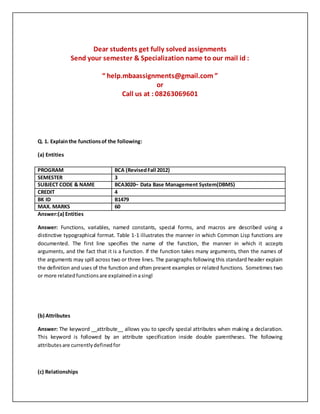
Get fully solved MBA assignments by email or call
- 1. Dear students get fully solved assignments Send your semester & Specialization name to our mail id : “ help.mbaassignments@gmail.com ” or Call us at : 08263069601 Q. 1. Explain the functions of the following: (a) Entities PROGRAM BCA (Revised Fall 2012) SEMESTER 3 SUBJECT CODE & NAME BCA3020– Data Base Management System(DBMS) CREDIT 4 BK ID B1479 MAX. MARKS 60 Answer:(a) Entities Answer: Functions, variables, named constants, special forms, and macros are described using a distinctive typographical format. Table 1-1 illustrates the manner in which Common Lisp functions are documented. The first line specifies the name of the function, the manner in which it accepts arguments, and the fact that it is a function. If the function takes many arguments, then the names of the arguments may spill across two or three lines. The paragraphs following this standard header explain the definition and uses of the function and often present examples or related functions. Sometimes two or more related functions are explained in a singl (b) Attributes Answer: The keyword __attribute__ allows you to specify special attributes when making a declaration. This keyword is followed by an attribute specification inside double parentheses. The following attributes are currently defined for (c) Relationships
- 2. Answer: A function is a set of rules to wich you input a value and get an output. So, the set of rules could be a human body and its complex Chemistry or the program inside a hard drive. An equation is simply two things being equal in at least Q. 2. List and explain the important responsibilities of database manager. Answer: A data administration (also known as a database administration manager, data architect, or information center manager) is a high level function responsible for the overall management of data resources in an organization. In order to perform its duties, the DA must know a good deal of system analysis and programming. These are the functions of a data Q. 3. Explain the Sequential File Organization with the help of diagrams. Answer: A process-data diagram is a diagram that describes processes and data that act as output of these processes. On the left side the meta-process model can be viewed and on the right side the meta concept model can be viewed. A process-data diagram can be seen as combination of an business process model and data model. The process-data diagram that is depicted at the right, gives an overview of all of these activities/processes and Q. 4. Explain the LIKE Predicate Answer: The LIKE predicate searches for strings that have a certain pattern. The pattern is specified by a string in which the underscore and percent sign may have special meanings. Trailing blanks in a pattern are part of the pattern.If the value of any of the arguments is null, the result of the LIKE predicate is unknown.The values for match-expression, pattern-expression, and escape-expression are compatible string expressions. There are slight differences in the types
- 3. Q. 5. Explain basic operations of Relational algebra? Answer: Relational database systems are expected to be equipped by a query language that can assist its user to query the database instances. This way its user empowers itself and can populate the results as required. There are two kinds of query languages, relational algebra and relational calculus. Relational algebra is a procedural query language, which takes instances of relations as input and yields instances of relations as output. It uses operators to perform Q. 6. Explain any two features of Features of Object Oriented System. Answer:For you new programmers or programmers new to OOP, this article will briefly explain the 4 major principles that make a language object-oriented: Encapsulation, Data Abstraction, Polymorphism and Inheritence. All examples will be in VB.Net, because in my opinion its easier for a new OOP programmer to read and understand at first. Certainly don’t think I’m saying you should use one .Net based language over another, as they all are based on the CLR/CLS and all end up as the same assembly language when compiled. Its your preference that Q. 7. Write a note on the following a)SUBSET Mapping Answer: SUBSET Mapping.A set is a well defined collection of objects. Well -defined means, that there exists a mechanism by which one is able to determine whether a given object belongs to a particular set or not. Objects that belong to a set are called elements or members of the set. Sets are usually denoted by capital letters and lower case letters are used to represent elements. A set A is said to be a subset of a set B; if and only if, every element of set A is also an element of set B. Such a relation between sets is denoted by A ⊆ B. It can also be read as ‘A is contained in B’. The set A is said to be a proper subset if A ⊆ B and A ≠B, and denoted by A ⊂ B. If there is even one member in A that is not a member of B, then A cannot be a subset of B. Empty set is b) SUPERSET Mapping Answer: SUPERSET Mapping. A persistent class with a superset mapping contains attributes derived from columns of multiple tables. This type of mapping is also known as table spanning. Superset mappings are used to create "view classes" that hide the underlying data model, or to map a class inheritance tree to the database using a Vertical
- 4. Dear students get fully solved assignments Send your semester & Specialization name to our mail id : “ help.mbaassignments@gmail.com ” or Call us at : 08263069601
